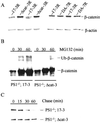The aspartate-257 of presenilin 1 is indispensable for mouse development and production of beta-amyloid peptides through beta-catenin-independent mechanisms
- PMID: 12070348
- PMCID: PMC124372
- DOI: 10.1073/pnas.132045399
The aspartate-257 of presenilin 1 is indispensable for mouse development and production of beta-amyloid peptides through beta-catenin-independent mechanisms
Abstract
To differentiate multiple activities of presenilin 1 (PS1), we generated transgenic mice expressing two human PS1 alleles: one with the aspartate to alanine mutation at residue 257 (hPS1D257A) that impairs the proteolytic activity of PS1, and the other deleting amino acids 340-371 of the hydrophilic loop sequence (hPS1Deltacat) essential for beta-catenin interaction. We show here that although hPS1Deltacat is fully competent in rescuing the PS1-null lethal phenotype, hPS1D257A does not exhibit developmental activity. hPS1D257A also leads to the concurrent loss of the proteolytic processing of Notch and beta-amyloid precursor protein (APP) and the generation of beta-amyloid peptides (Abeta). Further, by measuring the levels of endogenous Abeta(X-40) and Abeta(X-42) in primary neuronal cultures, we confirmed the concept that PS1 is indispensable for the production of secreted Abeta.
Figures





Similar articles
-
Presenilin 1 negatively regulates beta-catenin/T cell factor/lymphoid enhancer factor-1 signaling independently of beta-amyloid precursor protein and notch processing.J Cell Biol. 2001 Feb 19;152(4):785-94. doi: 10.1083/jcb.152.4.785. J Cell Biol. 2001. PMID: 11266469 Free PMC article.
-
Presenilin-1 controls the growth and differentiation of endothelial progenitor cells through its beta-catenin-binding region.Cell Biol Int. 2006 Mar;30(3):239-43. doi: 10.1016/j.cellbi.2005.11.003. Epub 2005 Dec 22. Cell Biol Int. 2006. PMID: 16376112
-
Substitution of a glycogen synthase kinase-3beta phosphorylation site in presenilin 1 separates presenilin function from beta-catenin signaling.J Biol Chem. 2001 Mar 9;276(10):7366-75. doi: 10.1074/jbc.M004697200. Epub 2000 Dec 4. J Biol Chem. 2001. PMID: 11104755
-
Presenilin structure, function and role in Alzheimer disease.Biochim Biophys Acta. 2000 Jul 26;1502(1):1-15. doi: 10.1016/s0925-4439(00)00028-4. Biochim Biophys Acta. 2000. PMID: 10899427 Review.
-
Biology of presenilins as causative molecules for Alzheimer disease.Clin Genet. 1999 Apr;55(4):219-25. doi: 10.1034/j.1399-0004.1999.550401.x. Clin Genet. 1999. PMID: 10361981 Review.
Cited by
-
Deletion of presenilin 1 hydrophilic loop sequence leads to impaired gamma-secretase activity and exacerbated amyloid pathology.J Neurosci. 2006 Apr 5;26(14):3845-54. doi: 10.1523/JNEUROSCI.5384-05.2006. J Neurosci. 2006. PMID: 16597739 Free PMC article.
-
Mouse models of Alzheimer's disease.Brain Res Bull. 2012 May 1;88(1):3-12. doi: 10.1016/j.brainresbull.2011.11.017. Epub 2011 Nov 28. Brain Res Bull. 2012. PMID: 22142973 Free PMC article. Review.
-
Changes in gamma-secretase activity and specificity caused by the introduction of consensus aspartyl protease active motif in Presenilin 1.Mol Neurodegener. 2008 May 12;3:6. doi: 10.1186/1750-1326-3-6. Mol Neurodegener. 2008. PMID: 18474109 Free PMC article.
-
Evidence that the COOH terminus of human presenilin 1 is located in extracytoplasmic space.Am J Physiol Cell Physiol. 2005 Sep;289(3):C576-81. doi: 10.1152/ajpcell.00636.2004. Epub 2005 Apr 20. Am J Physiol Cell Physiol. 2005. PMID: 15843437 Free PMC article.
-
Concerted type I interferon signaling in microglia and neural cells promotes memory impairment associated with amyloid β plaques.Immunity. 2022 May 10;55(5):879-894.e6. doi: 10.1016/j.immuni.2022.03.018. Epub 2022 Apr 19. Immunity. 2022. PMID: 35443157 Free PMC article.
References
-
- Selkoe D J. Trends Cell Biol. 1998;8:447–453. - PubMed
-
- Doan A, Thinakaran G, Borchelt D R, Slunt H H, Ratovitsky T, Podlisny M, Selkoe D J, Seeger M, Gandy S E, Price D L, Sisodia S S. Neuron. 1996;17:1023–1030. - PubMed
-
- Thinakaran G, Borchelt D R, Lee M K, Slunt H H, Spitzer L, Kim G, Ratovitsky T, Davenport F, Nordstedt C, Seeger M, et al. Neuron. 1996;17:181–190. - PubMed
-
- Thinakaran G, Harris C L, Ratovitsky T, Davenport F, Slunt H H, Price D L, Borchelt D R, Sisodia S S. J Biol Chem. 1997;272:28415–28422. - PubMed
Publication types
MeSH terms
Substances
Grants and funding
LinkOut - more resources
Full Text Sources
Molecular Biology Databases

